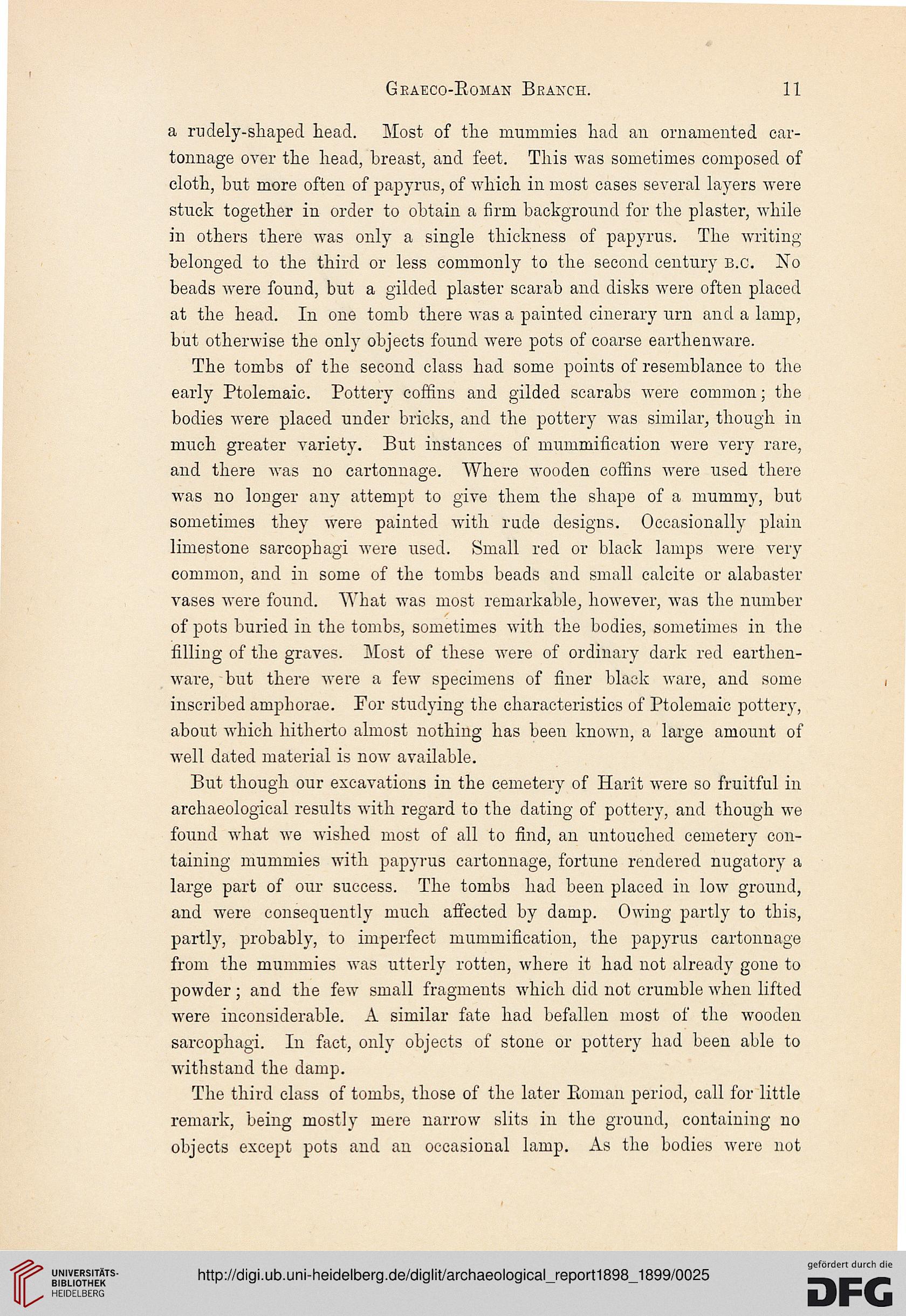Geaeco-Koman Beanch.
1 1
a rudely-shaped head. Most of tlie mummies had an ornamented car-
tonnage over the head, breast, and feet. This was sometimes composed of
cloth, but more often of papyrus, of which in most cases several layers were
stuck together in order to obtain a firm background for the plaster, while
in others there was only a single thickness of papyrus. The writing
belonged to the third or less commonly to the second century b.c. No
beads were found, but a gilded plaster scarab and disks were often placed
at the head. In one tomb there was a painted cinerary urn and a lamp,
but otherwise the only objects found were pots of coarse earthenware.
The tombs of the second class had some points of resemblance to the
early Ptolemaic. Pottery coffins and gilded scarabs were common; the
bodies were placed under bricks, and the pottery was similar, though in
much greater variety. But instances of mummification were very rare,
and there was no cartonnage. Where wooden coffins were used there
was no longer any attempt to give them the shape of a mummy, but
sometimes they were painted with rude designs. Occasionally plain
limestone sarcophagi were used. Small red or black lamps were very
common, and in some of the tombs beads and small calcite or alabaster
vases were found. What was most remarkable, however, was the number
of pots buried in the tombs, sometimes with the bodies, sometimes in the
filling of the graves. Most of these were of ordinary dark red earthen-
ware, but there were a few specimens of finer black ware, and some
inscribed amphorae. For studying the characteristics of Ptolemaic pottery,
about which hitherto almost nothing has been known, a large amount of
well dated material is now available.
But though our excavations in the cemetery of Harit were so fruitful in
archaeological results with regard to the dating of pottery, and though we
found what we wished most of all to find, an untouched cemetery con-
taining mummies with papyrus cartonnage, fortune rendered nugatory a
large part of our success. The tombs had been placed in low ground,
and were consequently much affected by damp. Owing partly to this,
partly, probably, to imperfect mummification, the papyrus cartonnage
from the mummies was utterly rotten, where it had not already gone to
powder ; and the few small fragments which did not crumble when lifted
were inconsiderable. A similar fate had befallen most of the wooden
sarcophagi. In fact, only objects of stone or pottery had been able to
with stand the damp.
The third class of tombs, those of the later Koman period, call for little
remark, being mostly mere narrow slits in the ground, containing no
objects except pots and an occasional lamp. As the bodies were not
1 1
a rudely-shaped head. Most of tlie mummies had an ornamented car-
tonnage over the head, breast, and feet. This was sometimes composed of
cloth, but more often of papyrus, of which in most cases several layers were
stuck together in order to obtain a firm background for the plaster, while
in others there was only a single thickness of papyrus. The writing
belonged to the third or less commonly to the second century b.c. No
beads were found, but a gilded plaster scarab and disks were often placed
at the head. In one tomb there was a painted cinerary urn and a lamp,
but otherwise the only objects found were pots of coarse earthenware.
The tombs of the second class had some points of resemblance to the
early Ptolemaic. Pottery coffins and gilded scarabs were common; the
bodies were placed under bricks, and the pottery was similar, though in
much greater variety. But instances of mummification were very rare,
and there was no cartonnage. Where wooden coffins were used there
was no longer any attempt to give them the shape of a mummy, but
sometimes they were painted with rude designs. Occasionally plain
limestone sarcophagi were used. Small red or black lamps were very
common, and in some of the tombs beads and small calcite or alabaster
vases were found. What was most remarkable, however, was the number
of pots buried in the tombs, sometimes with the bodies, sometimes in the
filling of the graves. Most of these were of ordinary dark red earthen-
ware, but there were a few specimens of finer black ware, and some
inscribed amphorae. For studying the characteristics of Ptolemaic pottery,
about which hitherto almost nothing has been known, a large amount of
well dated material is now available.
But though our excavations in the cemetery of Harit were so fruitful in
archaeological results with regard to the dating of pottery, and though we
found what we wished most of all to find, an untouched cemetery con-
taining mummies with papyrus cartonnage, fortune rendered nugatory a
large part of our success. The tombs had been placed in low ground,
and were consequently much affected by damp. Owing partly to this,
partly, probably, to imperfect mummification, the papyrus cartonnage
from the mummies was utterly rotten, where it had not already gone to
powder ; and the few small fragments which did not crumble when lifted
were inconsiderable. A similar fate had befallen most of the wooden
sarcophagi. In fact, only objects of stone or pottery had been able to
with stand the damp.
The third class of tombs, those of the later Koman period, call for little
remark, being mostly mere narrow slits in the ground, containing no
objects except pots and an occasional lamp. As the bodies were not





